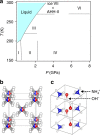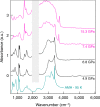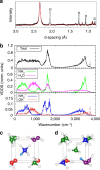Topologically frustrated ionisation in a water-ammonia ice mixture
- PMID: 29051485
- PMCID: PMC5648802
- DOI: 10.1038/s41467-017-01132-z
Topologically frustrated ionisation in a water-ammonia ice mixture
Abstract
Water and ammonia are considered major components of the interiors of the giant icy planets and their satellites, which has motivated their exploration under high P-T conditions. Exotic forms of these pure ices have been revealed at extreme (~megabar) pressures, notably symmetric, ionic, and superionic phases. Here we report on an extensive experimental and computational study of the high-pressure properties of the ammonia monohydrate compound forming from an equimolar mixture of water and ammonia. Our experiments demonstrate that relatively mild pressure conditions (7.4 GPa at 300 K) are sufficient to transform ammonia monohydrate from a prototypical hydrogen-bonded crystal into a form where the standard molecular forms of water and ammonia coexist with their ionic counterparts, hydroxide (OH-) and ammonium [Formula: see text] ions. Using ab initio atomistic simulations, we explain this surprising coexistence of neutral/charged species as resulting from a topological frustration between local homonuclear and long-ranged heteronuclear ionisation mechanisms.
Conflict of interest statement
The authors declare no competing financial interests.
Figures





References
-
- Hubbard W, Farlane JM. Structure and evolution of Uranus and Neptune. J. Geophys. Res. 1980;85:225–234. doi: 10.1029/JB085iB01p00225. - DOI
-
- Tobie G, Gautier D, Hersant F. Titan’s bulk composition constrained by Cassini-Huygens: Implication for internal outgassing. Astrophys. J. 2012;752:125. doi: 10.1088/0004-637X/752/2/125. - DOI
Publication types
LinkOut - more resources
Full Text Sources
Other Literature Sources
Molecular Biology Databases

